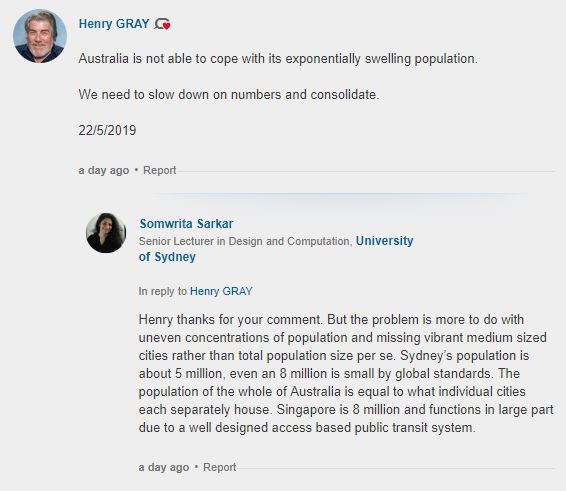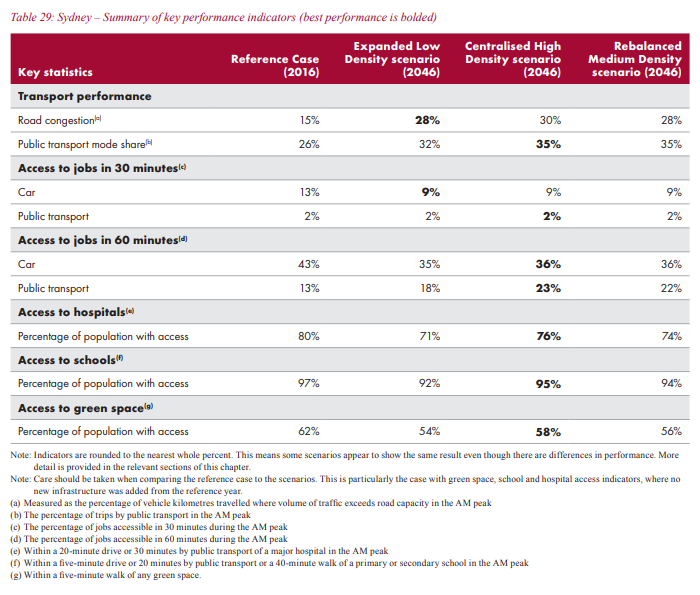Last year, the NSW Government made a hollow promise that Sydney would become a 30-minute city mid-century:
Planners envisage that by the middle of this century most Sydneysiders will be able to reach their place of work within 30 minutes using public transport or “active” options such as walking or riding.
The NSW government has released its Future Transport Strategy 2056 report, which suggests investment will increasingly be focused on “three cities” built around Western Sydney Airport, Greater Parramatta and the existing CBD.
“Customers will be able to travel to one of these cities or to their nearest centre within 30 minutes of where they live by public or active transport,” the report states.
“This will give people better access to access jobs, eduction and essential services”…
The report notes that by 2056 NSW will have more than 12 million residents. Sydney will be a global city similar in size to London or New York…
The Committee for Sydney joined the delusion:
The Committee for Sydney also backs the commission’s vision for a 30-minute city, and thinks improved public transport and increasing density is key to this and consequently, improving liveability.
“The plan is a really good one, now the key issue is delivering the right infrastructure to deliver that” he said.
Yesterday, a group of academics from the University of Sydney penned a convoluted article in The Conversation calling for Sydney to morph into a polycentric city in order to meet its 30-minute city goal:
Our results show that Sydney, paradoxically, remains strongly monocentric and strongly dispersed at the same time. The Sydney CBD accounts for 15% of jobs in the region, with the remaining 85% of jobs scattered around in weaker second-order centres and non-centres. Positive correlations exist between percentage of employed workers, trip-based centricity and the subcentre ranks.
But we see significant disparities between these ranks and accessibility centricities. This shows the spatial mismatches for commute lengths in the system.
A subcentre with high trip-centricity, employing a high percentage of workers, but relatively lower auto- and transit-based accessibility centricity, implies that even though a significant percentage of the population comes to this location to work, access to jobs at this centre within 30 minutes is low.
A policy response would be to increase the accessibility of jobs from this location, as it already serves as a centre. This situation is particularly clear in the cases of Parramatta-Rosehill and Macquarie Park-Marsfield. Penrith and Liverpool too have extremely weak accessibility centricity.
Talk about pseudo science mumbo jumbo. The response from co-author Somwrita Sarkar to a reader’s comment about excessive population growth is also hilarious:

One wonders why policy makers and commentators continually ignore Infrastructure Australia’s projections. These show that no matter what Sydney does to cope with its population (read migrant) influx – i.e. builds up, spreads-out, or does a combination of the two – public transport’s modal share will barely increase, road congestion will dramatically worsen, and access to jobs, schools, hospitals and green space will all deteriorate as Sydney’s population balloons to 7.4 million people respectively by 2046 (let alone to nearly 10 million by 2066):

As shown above, access to jobs within 30-minutes in Sydney will fall from 15% currently to just 11% under the best case scenario.
One wonders whether these gaslighters even bothered to read Infrastructure Australia’s report? Because if they did, they might think twice before spinning urban planning fairy tales.
Sydney’s living standards will unambiguously erode if the mass immigration ‘Big Australia’ program persists.

